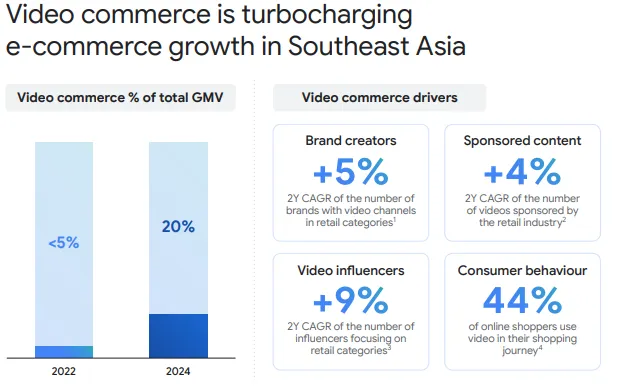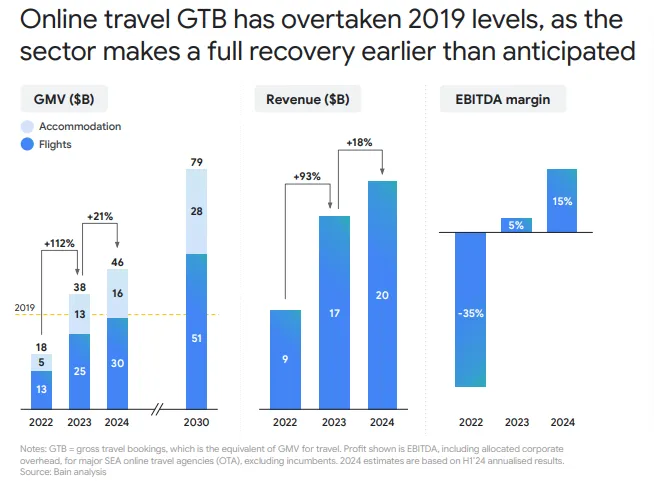Summary
To say that Southeast Asia's digital economy is at a pivotal moment would be an understatement. According to the latest e-Conomy SEA 2024 report by Google, Temasek, and Bain & Company, the region's digital economy is projected to reach $263 billion this year—marking a 15% growth in online spending from previous year, though this represents the slowest growth rate since 2017. Despite this deceleration, the region has undergone remarkable digital transformation.

Source: Bain and Company
Notably, investment patterns have shifted significantly, with a focus on sustainable financial practices rather than aggressive expansion. While private funding has reached record lows, the region has attracted approximately $30 billion in foreign investment from tech giants like Apple, Microsoft, and Nvidia, particularly in AI infrastructure.
Now that we understand the region's evolving landscape, which industries in particular are leading the charge?
Here we explore Southeast Asia's fastest-growing industries to watch out for.
E-commerce and Video Commerce
E-commerce continues to be the powerhouse of Southeast Asia's digital economy, with projected values reaching $159 billion in 2024, up from $138 billion in 2023. A particularly exciting development is the rise of video commerce, which now accounts for 20% of e-commerce value.

Source: Bain and Company
Video commerce has emerged as a game-changing trend, transforming the traditional e-commerce landscape. This is driven by changing consumer behavior, with over 40% of online shoppers now relying on videos throughout their shopping journey, from product discovery to final purchase.
The success of video commerce stems from multiple formats: live shopping sessions where sellers create urgency through time-limited deals and real-time interaction; influencer-driven content where trusted creators showcase products with seamless purchase links; and integrated video features within traditional e-commerce platforms, such as seller-uploaded product demonstrations and video reviews.
Brands are leveraging this trend and increasingly partnering with creators outside their core categories to expand reach. This cross-category collaboration has proven effective in reaching new audiences and enhancing brand relevance across different market segments.
Digital Financial Services
Digital financial services have emerged as a cornerstone of Southeast Asia's digital economy, with revenues surging from $22 billion in 2022 to $33 billion in 2024. This growth is largely fueled by the widespread adoption of QR code payments, particularly in Indonesia and Vietnam, supported by new partnerships between payment card networks and major e-wallet providers. Cross-border payment initiatives, such as the QR payment connectivity between Indonesia and Singapore, have further accelerated adoption. The sector has seen gross transaction value (GTV) reach $1.138 trillion in 2024, with digital payments now accounting for 56% of total GTV in the region.

Source: Bain and Company
The lending segment remains the biggest revenue driver, representing approximately 65% of total DFS revenue. Digital banks have played a crucial role in this growth, leveraging generative AI for virtual assistants and credit scoring to serve underserved customers more effectively.
Despite regulatory measures to prevent excessive credit issuance, such as lending and charge rate limits, the digital loan book has maintained healthy growth with remarkably low non-performing loan (NPL) rates. Leading peer-to-peer lenders, particularly in Indonesia, have successfully kept NPLs around 2-3% even as loans outstanding doubled from $2 billion to $4 billion between 2022 and 2024.
AI and Cloud Infrastructure
Southeast Asia is a significant player in the global AI landscape, particularly in data centers and innovative end-layer applications. In the first half of 2024 alone, the region attracted substantial investments in AI-ready data center infrastructure, with planned capacity increases of up to 500% in some markets.

Source: Bain and Company
Singapore leads with 1,000MW current capacity and planned 30% expansion, while Malaysia and Indonesia are seeing dramatic growth with planned capacity increases of 270% and 500% respectively. This infrastructure boom is expected to empower accelerated computing capabilities, enhance AI services, and support data growth both regionally and globally.
Several unique advantages make Southeast Asia particularly attractive for AI development. The region’s young and growing population, coupled with high rates of digital literacy and AI enthusiasm, provides a large and receptive market for AI-powered products and services. Markets like Singapore, the Philippines, and Malaysia rank among the global top 10 for AI-related searches and demand.
The relatively stable regional geopolitical environment and rapidly growing economies have attracted major tech companies to invest in infrastructure, while government support through national strategies, funding initiatives, and regulatory sandboxes has created a favorable environment for AI innovation. This comprehensive ecosystem approach has positioned SEA to compete effectively in both AI-ready data center development and innovative end-layer applications, where the region faces fewer structural barriers to entry.
Digital Trust and Cybersecurity
While overall fraud rates have declined by 24% since 2022, thanks to enhanced risk controls and increased user awareness, the sophistication of cyber threats has intensified significantly.

Source: Bain and Company
Affluent users are being particularly targeted and are 1.3 times more likely to be scammed and typically lose twice as much as other user groups when successfully targeted. The data reveals a paradoxical situation where approximately half of all digital users have fallen victim to online scams, despite expressing confidence in their ability to spot and avoid them.
Digital businesses are prioritising security and privacy by design, implementing robust cybersecurity measures, and being more transparent about their data collection and usage practices. This includes deploying AI-powered fraud detection systems and embedding enhanced security controls to protect users.
While companies focus on technological solutions, governments are implementing policies that support AI innovation while mitigating risks, and civil society organisations are playing a crucial role in raising awareness about cybersecurity risks and empowering consumers to protect themselves online. The challenge remains in balancing security measures with user experience, as the region continues to see high rates of digital adoption.
Travel and Tourism

Source: Bain and Company
The online travel sector has not only recovered but surpassed pre-pandemic levels earlier than anticipated, with gross travel bookings (GTB) reaching $46 billion in 2024. The aviation sector has been a particularly strong performer, exceeding pre-pandemic levels with significant growth in airfares, especially for flights originating from Singapore. The accommodation segment has also seen notable evolution, with a clear shift in consumer preferences towards luxury travel experiences, while vacation rental GTB shows some deceleration.
Regional travel patterns have shifted significantly, with over 70% of Southeast Asian travel spending now remaining within the Asia Pacific region, including SEA itself. This highlights the increasing appeal and accessibility of destinations closer to home, supported by expanding flight capacity within the region.
Japan has emerged as a particularly attractive destination, seeing a 5 percentage point year-on-year increase in consumer spend share - the highest among all destination countries - driven largely by the relative weakness of the Japanese yen. OTAs have adapted to these changing patterns by raising their commission rates to match global peers while simultaneously promoting high-margin adjacent offerings such as car rentals, guided trips, and pay-later programmes.
Start a business in Singapore with Aspire
Its central location in SEA makes Singapore an excellent base for regional expansion. If you need help to set up your business in Singapore, look no further than Aspire Business Account.
With multi-currency options, native integrations with top accounting software, and built-in expense management, Aspire is the all-in-one platform to supercharge your business.







.webp)
.png)

%201.webp)


.webp)